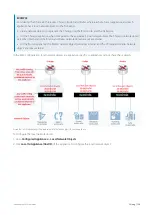
Exinda Network Orchestrator
3 Using
|
131
3 Using
This topic focuses on the day-to-day use of your Exinda Appliance like defining traffic policies, setting alerts, monitoring
performance, monitoring traffic, and understanding solutions and recommendations.
3.1 Defining a network environment
3.3 Monitoring applications with the [[[Undefined variable MyVariables.ExSoluCtr]]]
3.5 Configuring for common use cases and scenarios
3.6 Managing Exinda Appliances with EMC
3.7 Service Delivery Point (SDP)
3.1 Defining a network environment
One of the first things you do after connecting an Exinda to your network, is define how the Exinda sees your network
and its components.
As an analogy, imagine walking around your office or data center and placing sticky notes on all the servers, cables and
racks to identify them and note what they do. That's essentially what you do when you define objects in Exinda.
There are a variety of object types available, representing almost every physical, virtual and logical network component in
your environment.
3.1.1 Adding network objects
Network objects represent hosts on a network and can include subnets, single hosts, or groups of both. Once defined, a
network object may be used throughout the Exinda Appliance for monitoring and identifying which traffic should be
processed in the policy engine.
Network objects are in the configurations of other objects, such as applications, adaptive response rules, application
performance score objects, and application performance metric objects.
Network objects are also used to determine which traffic is considered inbound to your network and which traffic is
outbound.
The location of a network object determines the direction of traffic. If one end of the conversation is defined in an
external network object and the other is defined in an internal network object, then traffic from an external network
object to an internal network object is considered inbound traffic.
Conversely, traffic from an internal network object to an external network object is considered outbound traffic.
You can indicate whether you want to report on the traffic relative to the network object, that is chart the traffic in and
out of a given network object.
Adding network objects in the Exinda Web UI
By checking the Subnet Report checkbox, the data for the network object will be shown on the subnet monitor page.
This setting only affects the display of the data. The data will be collected regardless of this setting.
Some network objects are automatically created by the appliance:
ALL
,
private net
and
local
Содержание EXNV-10063
Страница 98: ...Exinda Network Orchestrator 2 Getting started 98 6 Click New The New Virtual Hard Disk wizard opens ...
Страница 99: ...Exinda Network Orchestrator 2 Getting started 99 7 Select VHDX as the Disk Format type and click Next ...
Страница 130: ...Exinda Network Orchestrator 2 Getting started 130 Screenshot 35 The life cycle of configuration status ...
Страница 369: ...Exinda Network Orchestrator 4 Settings 369 ...
Страница 411: ...Exinda Network Orchestrator 4 Settings 411 Screenshot 168 P2P OverflowVirtualCircuit ...
Страница 420: ...Exinda Network Orchestrator 4 Settings 420 Screenshot 175 Students OverflowVirtualCircuit ...
Страница 451: ...Exinda Network Orchestrator 4 Settings 451 ...
















































